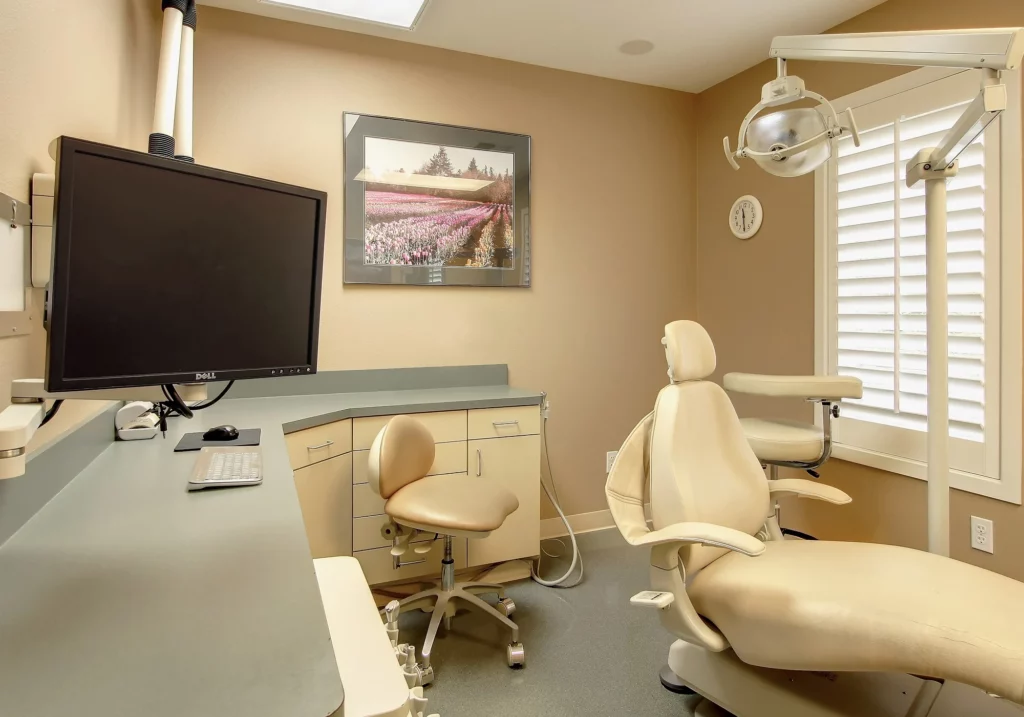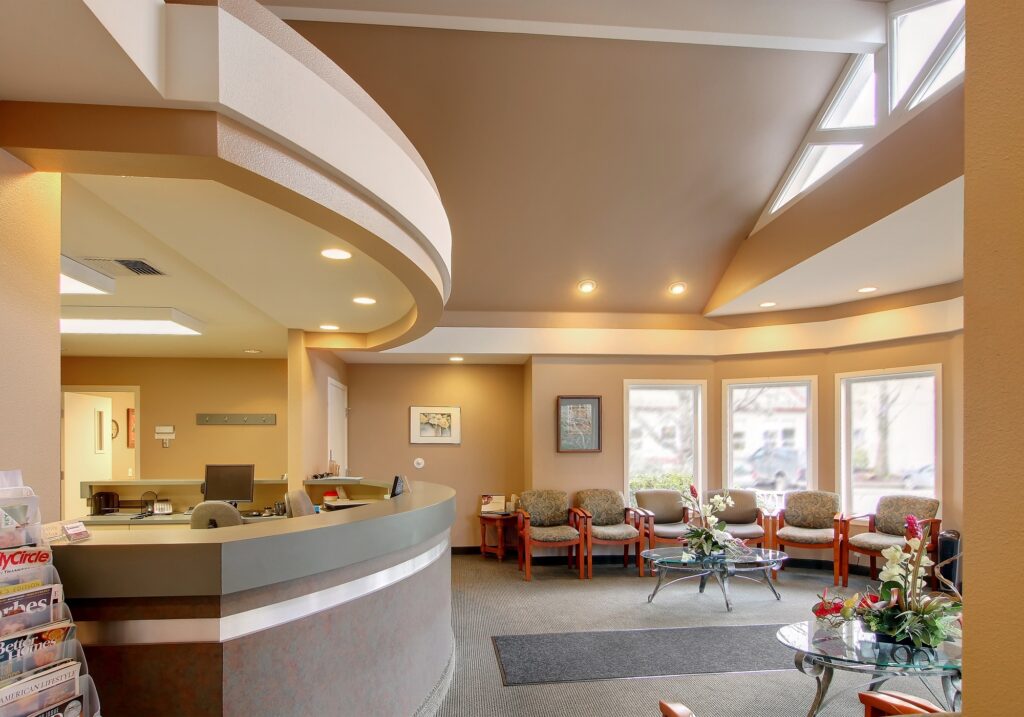Professional Teeth Cleaning
WHAT IS LASER DENTISTRY?
Laser dentistry is a cutting-edge technique that utilizes a thin beam of focused light to perform various dental treatments, with a particular focus on periodontal care. In the context of a periodontal office, laser dentistry is designed to address periodontal and peri-implant diseases, offering fast and minimally-invasive procedures.
This innovative approach has been shown to be effective in treating periodontal disease, as it can be used to cut away diseased gum tissue and provide antibacterial treatment, contributing to improved dental health.
Moreover, studies have demonstrated that laser therapy used as an adjunct to periodontal treatment is more effective than nonsurgical methods.

Professional teeth cleaning
Professional teeth cleaning is an effective procedure in keeping the oral cavity in proper health and halting the progression of gum disease. The benefits include:
- Plaque removal. Tartar (also referred to as calculus) and plaque buildup, both above and below the gum line, can result in serious periodontal problems. Unfortunately, even with a proper home brushing and flossing routine, it can be impossible to remove all debris, bacteria and deposits from gum pockets. The experienced eye of a dentist or hygienist using specialized dental equipment is necessary to catch potentially damaging buildup.
- A healthier-looking smile. Stained and yellowed teeth can dramatically decrease the esthetics of a smile. Prophylaxis is an effective treatment in ridding the teeth of these unsightly stains.
- Fresher breath. Bad breath (or halitosis) is generally indicative of advancing periodontal disease. A combination of rotting food particles (possibly below the gum line) and potential gangrene stemming from gum infection, results in bad breath. The routine removal of plaque, calculus and bacteria at our facility can noticeably improve halitosis and reduce infection.
Dental prophylaxis can be performed at our office or by your general dentist. It may be beneficial to have your regular cleanings done by Dr. Kaindl, who is more familiar with the full scope of your periodontal disease. We recommend that prophylaxis be performed twice annually as a preventative measure, but should be completed every 3-4 months for periodontitis sufferers.
It should be noted that gum disease cannot be completely reversed, but prophylaxis is one of the tools Drs. Kaindl can use to effectively halt its progression.

Oral Cancer Exam
According to the American Cancer Society, over 30,000 cases of oral cancer are diagnosed each year, with over 7000 of these cases resulting in the death of the patient. Fortunately, oral cancer can be diagnosed with an annual cancer exam provided by Dr. Kaindl. If caught early, oral cancer can be effectively treated.
Oral cancer is a pathologic process, which begins by producing no symptoms making it hard to recognize without an exam. There are many types of oral cancer, including teratoma, adenocarcinoma and melanoma. The most common form of oral cancer is malignant squamous cell carcinoma, which typically originates in the lip and mouth tissue. There are many other places in which oral cancers occur, including: the tongue, salivary glands, throat, gums, and face.
WHAT TO EXPECT FROM AN ORAL CANCER EXAM
The oral cancer examination is completely painless. Drs. Kaindl will look for abnormalities and feel the face, glands, and neck for unusual bumps. Lasers may be used to highlight pathologic changes, and can “look” below the surface for spots and lesions invisible to the naked eye. Some of the signs that will be investigated are red patches and sores. Red patches on the floor of the mouth, or the front of the tongue, and bleeding sores which fail to heal easier, can be indicative of cancerous changes. Leukoplakia is a hardened white or gray, slightly raised lesion that can appear inside the mouth, and may be cancerous. Signs of these will be examined as well. Finally, soreness, lumps or the general thickening of tissue anywhere in the throat or mouth can signal pathologic signs, and will be examined.
If abnormalities, lesions, lumps, or leukoplakia are apparent, Drs. Kaindl will implement a treatment plan that is right for you. Treatment options vary according to the precise diagnosis, but may include: excision, radiation therapy, and chemotherapy.
It is also important to note that over 75% of oral cancers are linked with avoidable behaviors such as smoking, tobacco use, and excessive alcohol consumption. Dr. Kaindl can provide you with literature and options about quitting dangerous behaviors such as tobacco use.
Oral Hygiene
While brushing the outside surfaces of your teeth, position the brush at a 45-degree angle where your gums and teeth meet. Gently move the brush in a circular motion several times using small, gentle strokes. Use some pressure while putting the bristles between the teeth, but not so much pressure that you feel any discomfort. When you are done cleaning the outside surfaces of all your teeth, follow the same directions while cleaning the inside of the back teeth.
To clean the inside surfaces of the upper and lower front teeth, hold the brush vertically. Make several gentle back-and-forth strokes over each tooth. Don’t forget to gently brush the surrounding gum tissue.
Next you will clean the biting surfaces of your teeth. To do this, use short, gentle strokes. Change the position of the brush as often as necessary to reach and clean all surfaces. Try to watch yourself in the mirror to make sure you clean each surface. After you are done, rinse vigorously to remove any plaque you might have loosened while brushing.
If you have any pain while brushing or have any questions about how to brush properly, please be sure to call the office.

HOW TO FLOSS
Periodontal disease usually appears between the teeth where your toothbrush cannot reach. Flossing is a very effective way to remove plaque from those surfaces. However, it is important to develop the proper technique. The following instructions will help you, but remember it takes time and practice.
Start with a piece of floss (waxed is easier) about 18″ long. Lightly wrap most of the floss around the middle finger of one hand. Wrap the rest of the floss around the middle finger of the other hand.
To clean the upper teeth, hold the floss tightly between the thumb and forefinger of each hand. Gently insert the floss tightly between the teeth using a back-and-forth motion. Do not force the floss or try to snap it into place. Bring the floss to the gum line then curve it into a C-shape against one tooth. Slide it into the space between the gum and the tooth until you feel light resistance. Move the floss up and down on the side of one tooth. Remember there are two tooth surfaces that need to be cleaned in each space. Continue to floss each side of all the upper teeth. Be careful not to cut the gum tissue between the teeth. As the floss becomes soiled, turn from one finger to the other to get a fresh section.
To clean between the bottom teeth, guide the floss using the forefinger of both hands. Do not forget the back side of the last tooth on both sides, upper and lower.
When you are done, rinse vigorously with water to remove plaque and food particles. Do not be alarmed if during the first week of flossing your gums bleed or are a little sore. If your gums hurt while flossing you could be doing it too hard or pinching the gum. As you floss daily and remove the plaque your gums will heal and the bleeding should stop.
CARING FOR SENSITIVE TEETH
Sometimes after dental treatment, teeth are sensitive to hot and cold. If the mouth is kept clean, this sensation should not last long. However, if the mouth is not kept clean, the sensitivity will remain and could become more severe. If your teeth are especially sensitive, consult with Dr. Kaindl. A medicated toothpaste or mouth rinse made especially for sensitive teeth may be recommended.
CHOOSING ORAL HYGIENE PRODUCTS
There are so many products on the market that choosing the right one can be difficult. Here are some suggestions for selecting dental care products that will work for most patients:
- Automatic and “high-tech” electronic toothbrushes are safe and effective for the majority of users. Oral irrigators (water spraying devices) will rinse your mouth thoroughly, but will not remove plaque. You need to brush and floss in conjunction with the irrigator. We see excellent results with the electric toothbrushes “Rotadent” and “Interplak.”
- Some toothbrushes have a rubber tip on the handle that is used to massage the gums after brushing. There are also tiny brushes (interproximal toothbrushes) that clean between your teeth. If these are used improperly you could injure the gums, so be sure to discuss proper use with Drs. Kaindl.
- If used in conjunction with brushing and flossing, fluoride toothpastes and mouth rinses can reduce tooth decay by as much as 40 percent. Remember, these rinses are not recommended for children under six years of age.
- Tartar control toothpastes will reduce tartar above the gum line, but because gum disease starts below the gum line, these products have not been proven to reduce the early stage of gum disease.
- Anti-plaque rinses, approved by the American Dental Association, contain agents that may help control signs of early gum disease. Use these in conjunction with brushing and flossing.
Drs. Kaindl can offer the best advice to help you select the right dental products.

SCHEDULE YOUR CONSULTATION
The only way to receive an accurate price quote is to call us and come in for a consultation, and we can give you a specific price for your case. Please call us at Salem Periodontal Specialists, (503)-585-4281 to schedule your consultation.
